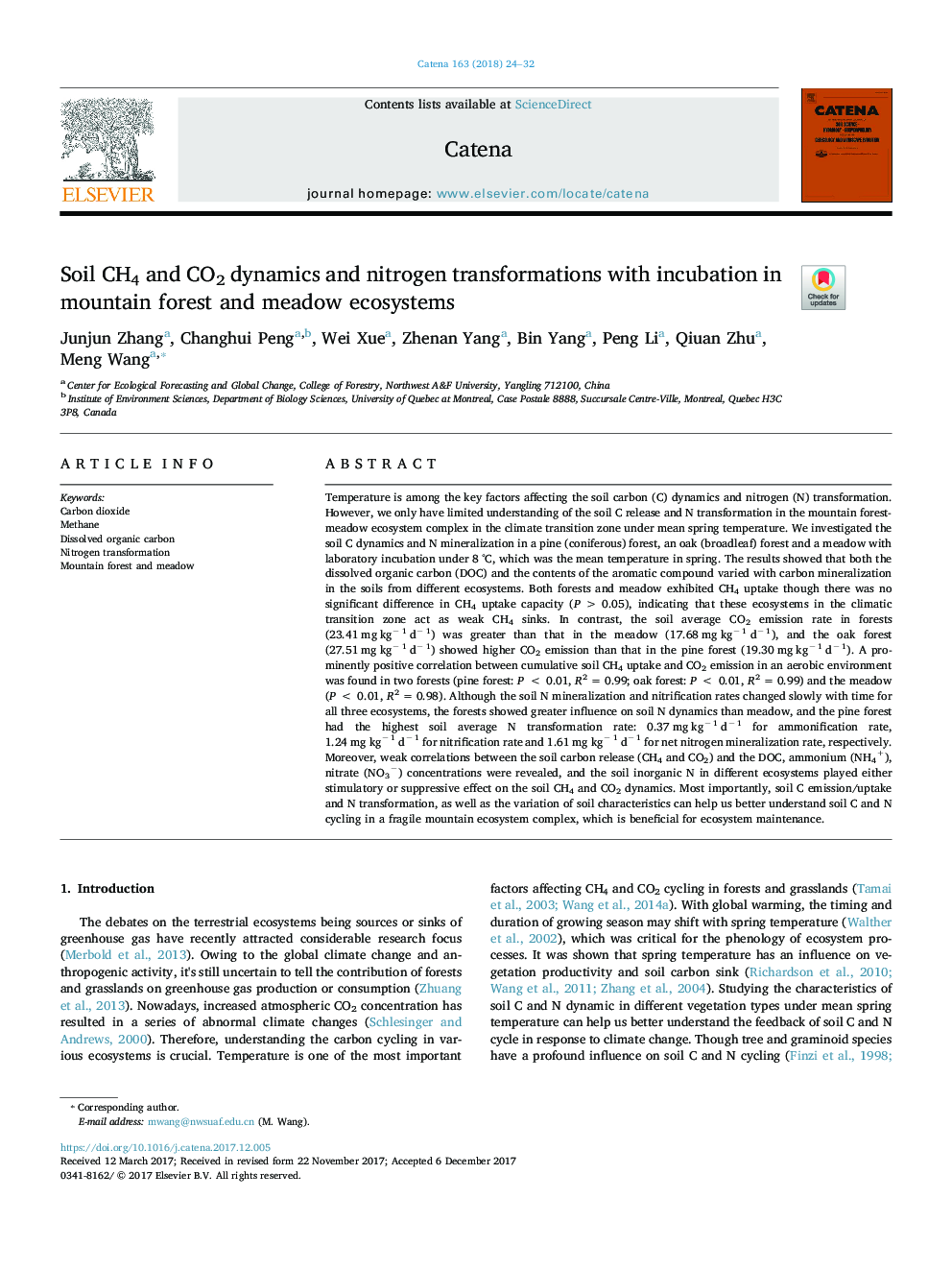| کد مقاله | کد نشریه | سال انتشار | مقاله انگلیسی | نسخه تمام متن |
|---|---|---|---|---|
| 8893673 | 1629191 | 2018 | 9 صفحه PDF | دانلود رایگان |
عنوان انگلیسی مقاله ISI
Soil CH4 and CO2 dynamics and nitrogen transformations with incubation in mountain forest and meadow ecosystems
دانلود مقاله + سفارش ترجمه
دانلود مقاله ISI انگلیسی
رایگان برای ایرانیان
کلمات کلیدی
موضوعات مرتبط
مهندسی و علوم پایه
علوم زمین و سیارات
فرآیندهای سطح زمین
پیش نمایش صفحه اول مقاله

چکیده انگلیسی
Temperature is among the key factors affecting the soil carbon (C) dynamics and nitrogen (N) transformation. However, we only have limited understanding of the soil C release and N transformation in the mountain forest-meadow ecosystem complex in the climate transition zone under mean spring temperature. We investigated the soil C dynamics and N mineralization in a pine (coniferous) forest, an oak (broadleaf) forest and a meadow with laboratory incubation under 8 °C, which was the mean temperature in spring. The results showed that both the dissolved organic carbon (DOC) and the contents of the aromatic compound varied with carbon mineralization in the soils from different ecosystems. Both forests and meadow exhibited CH4 uptake though there was no significant difference in CH4 uptake capacity (P > 0.05), indicating that these ecosystems in the climatic transition zone act as weak CH4 sinks. In contrast, the soil average CO2 emission rate in forests (23.41 mg kgâ 1 dâ 1) was greater than that in the meadow (17.68 mg kgâ 1 dâ 1), and the oak forest (27.51 mg kgâ 1 dâ 1) showed higher CO2 emission than that in the pine forest (19.30 mg kgâ 1 dâ 1). A prominently positive correlation between cumulative soil CH4 uptake and CO2 emission in an aerobic environment was found in two forests (pine forest: P < 0.01, R2 = 0.99; oak forest: P < 0.01, R2 = 0.99) and the meadow (P < 0.01, R2 = 0.98). Although the soil N mineralization and nitrification rates changed slowly with time for all three ecosystems, the forests showed greater influence on soil N dynamics than meadow, and the pine forest had the highest soil average N transformation rate: 0.37 mg kgâ 1 dâ 1 for ammonification rate, 1.24 mg kgâ 1 dâ 1 for nitrification rate and 1.61 mg kgâ 1 dâ 1 for net nitrogen mineralization rate, respectively. Moreover, weak correlations between the soil carbon release (CH4 and CO2) and the DOC, ammonium (NH4+), nitrate (NO3â) concentrations were revealed, and the soil inorganic N in different ecosystems played either stimulatory or suppressive effect on the soil CH4 and CO2 dynamics. Most importantly, soil C emission/uptake and N transformation, as well as the variation of soil characteristics can help us better understand soil C and N cycling in a fragile mountain ecosystem complex, which is beneficial for ecosystem maintenance.
ناشر
Database: Elsevier - ScienceDirect (ساینس دایرکت)
Journal: CATENA - Volume 163, April 2018, Pages 24-32
Journal: CATENA - Volume 163, April 2018, Pages 24-32
نویسندگان
Junjun Zhang, Changhui Peng, Wei Xue, Zhenan Yang, Bin Yang, Peng Li, Qiuan Zhu, Meng Wang,